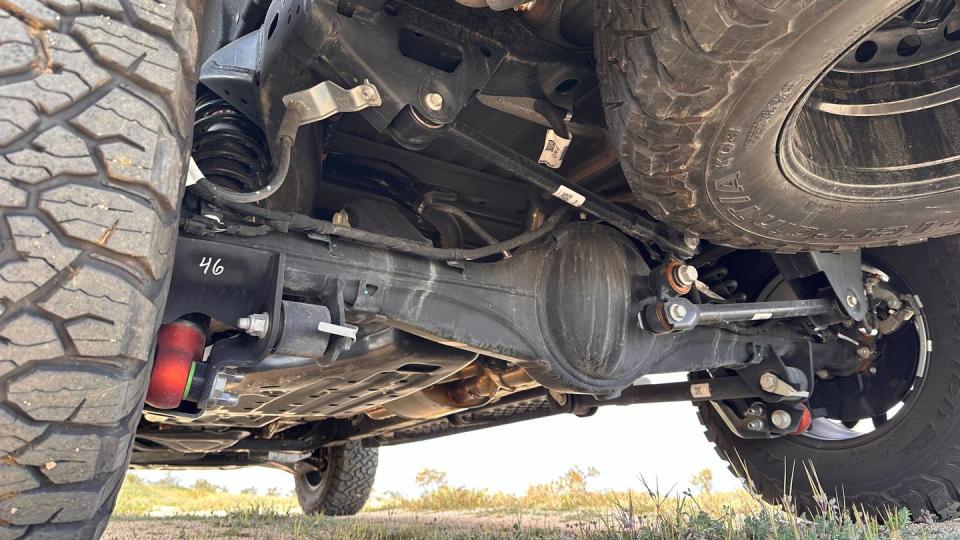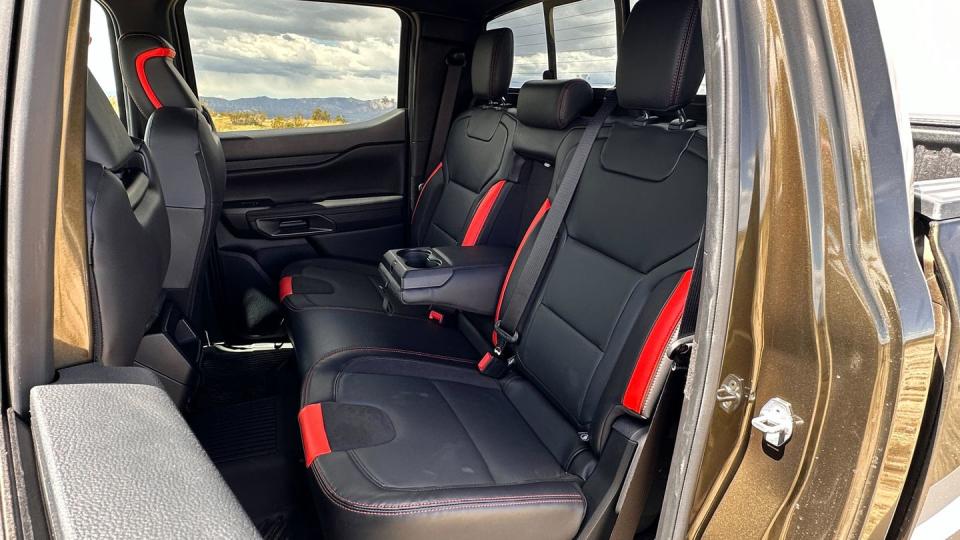Tight Trails, Garages, and Budgets: The 2024 Ford Ranger Raptor Can Tackle Them All
The Mojave Desert is crisscrossed with lonely two-track trails that lead to old mines, primitive camping sites, and little-known points of interest. We wandered down one such track in a 2024 Ranger Raptor in search of a memorial to the crew of a crashed YB-49—an early flying-wing precursor to the B-2 bomber—that went down in 1948. The co-pilot on that fateful day was Captain Glen Edwards, and today the nearby Edwards Air Force Base bears his name. The narrow trail we were following hugged the rough contours of the land and wound between scraggly creosote bushes as we made our way uncertainly toward ground zero. We were certain of one thing, however: This path was no place for an F-150 Raptor.
As much as we love the Ford F-150 Raptor and its undeniable off-road prowess, we've always thought that it's too damn big and wide for such trails. It is legally required to have commercial truck clearance lights, for crying out loud. Most two-track trails, on the other hand, were blazed by narrower machines—like Jeep CJs. They're not wide, in other words, and the only pruning the vegetation gets comes from the occasional passage of more Jeeps, Toyota 4Runners and, increasingly, compact off-road pickups. "Trail striping" is a common F-150 Raptor hazard, but the Ranger Raptor is rightsized to combat this existential peril to resale value.
Don't get us wrong. The Ranger Raptor is still a wide-stance off-road pickup in the Raptor mold—0.1 inch narrower than a regular F-150, at least out at the fenders. But it's built up from the new 2024 Ford Ranger, a compact truck that's just 75.5 inches wide. Sure, the Ranger Raptor is 4.3 inches broader largely because its long-travel suspension sets its tires 3.5 inches farther apart, but the junior Raptor is still 6.8 inches narrower than its big brother. That buys you a lot of maneuvering space between woody shrubs and allows a driver more freedom to choose a line on tricky trails that lack vegetation. Even if you never go off-road, the above still pays dividends in parking lots and—at nearly two feet shorter and some four inches lower—in your garage.

The Ranger Raptor gets its motivation from the same twin-turbocharged 3.0-liter V-6 that powers the Bronco Raptor. Because of its longer exhaust piping, the Ranger Raptor makes 405 horsepower and 430 pound-feet instead of 418 horsepower and 440 pound-feet. That's nothing to fret over, because the Ranger Raptor's 5372-pound curb weight is 392 pounds lighter than a Bronco Raptor we tested. All of this shows up clearly at the track, where the Ranger Raptor gets to 60 mph in 5.3 seconds, finishes the quarter-mile in 14.1 seconds at 97 mph, and romps from 50 to 70 mph in 3.9 seconds. The Bronco lags in all three measures. The Ranger Raptor is only a tenth slower to 60 mph than the F-150 version, but it executes the 50-to-70-mph pass a tenth quicker. In the contest that really matters, the Ranger Raptor's 5.3-second romp to 60 mph destroys the Chevrolet Colorado ZR2's 6.8-second effort, which it rightly should with 95 extra ponies.
Underneath, the Raptor's 3.5-inch front track increase comes primarily from longer forged aluminum upper and lower control arms. Its fortified steering rack is a bespoke piece instead of a carryover from the regular Ranger, with longer tie rods. Damping comes from 2.5-inch Fox Live-valve shocks with variable compression damping, and there's a front anti-roll bar. In back, the axle tube is 3.5 inches broader, fortified by trusswork, and located by four trailing links. Lateral control comes from a Watt's linkage instead of the usual Panhard rod, a more expensive approach that provides greater cornering stiffness and symmetrical roll behavior. The springs are coil-overs surrounding the Fox dampers, but there's no rear anti-roll bar.

On the road, the Raptor delivers a settled ride that sometimes borders on supple. Cracked surfaces can get the big 33-inch BFGoodrich KO3s a-thumpin', but it's never the dominant theme. The Ranger Raptor even steers more assuredly than the regular model, on account of a sportier effort tune. It bends nicely into turns, too, but only up to a point. If you push hard, the square-shouldered off-road tires will balk. They only manage 0.69 g on the skidpad, with abundant understeer at the limit. Same is true of the brakes, which feel capable in daily use but only manage 70-mph panic stops in a woeful 218 feet when passed through the KO3 filter. It's all typical Raptor stuff that's common to its Bronco and F-150 relations, though. Drive accordingly.
The assembled parts work supremely well at speed in the desert. Once we got to the monument and paid our respects, our route back was the same way we came in. We knew what to expect and where to turn, so we hammered it. The Raptor's suspension and tires dug in, and its tidy dimensions allowed us to flick it between outstretched creosote limbs with nary a scratch. Dips, crests, and drainages we'd barely noticed on the tentative drive in felt like an off-road course at triple the speed, and the Raptor's 10 inches of front and rear suspension travel soaked it all up greedily. It's clear that the Ranger Raptor is most definitely a rightsized machine that's scaled perfectly for this environment, and it has the suspension to match.
Earlier, we'd driven it slowly on rockier trails that were more technical. This gave us a chance to sort through the various driving modes, which are accessed through a rotary knob shared with the regular Ranger, but with three extra modes: Off-Road, Baja, and Rock Crawl. Inside its perimeter there are five buttons instead of the Ranger's four. 2H, 4H, 4L (high and low range), and a central trailer tow button are here, but the Raptor alone has a 4A mode that automatically shifts into four-wheel drive in response to traction conditions.

Selecting Off-Road brings up 4H as the initial default, and Rock Crawl automatically goes for 4L. Baja starts in 4H (and switches off the stability and traction control), but you can run it in 2H or 4L. The electronically locking rear differential comes on automatically when you select Off-Road or Rock Crawl (unlocking it is a driver action), but you select it manually in Baja. Frankly, we think it should behave this way in all three modes, because locking any differential should be a conscious decision you make at need. Meanwhile, the front locker is only selectable in low range in Rock Crawl with the rear diff locked, which is fair enough.
All of these mode changes take little time, with the usual shift to neutral being the only delay going into and out of 4L. We're not crazy about the location of the diff-lock buttons, which only appear on the lower half of the touchscreen after you press the off-road status button next to the rotary knob. Between the virtual front and rear diff lock buttons you'll find the Trail Control button, which, when engaged, is an off-road cruise control that works uphill or down. You use the regular cruise control buttons to set and adjust speed in increments of 1 mph in 4H and 0.5 mph in 4L. It's not a bad system, but manual control is easy enough with the 10-speed automatic, which delivers a 61.59:1 crawl ratio in low range and first gear.

In normal truck terms, the Raptor is packed with all the interior design goodness of the new Ranger, including its dual gloveboxes, Bang & Olufsen sound system, and 12.4-inch vertical touchscreen. The Raptor seats are comfy and hold tight, and it's generally a pleasant place to while away the miles—if a bit monochromatic in the Raptor's all-black-with-red-accents theme. The five-foot bed behind the crew cab is similarly able to carry four-foot plywood and drywall panels flat on the deck, and the bed comes replete with 110- and 12-volt outlets, under-rail lighting, and numerous attachment points for various factory and aftermarket add-ons. The only thing missing is the optional bed step from the regular Ranger, which had to be omitted because the Raptor's dual exhausts run through the mounting space.
What does it cost for all of this? The starting price is $57,065. Yes, a ZR2 costs less to start, but there are several options you'd need to add to match equipment, and you'd never get as nice an interior or the extra 95 horsepower. Meanwhile, the essentially loaded Raptor offers few options. Beadlock-capable wheels ($1495) are one that our test truck didn't have, but ours did have the always dubious Raptor graphics ($750), a spray-in bedliner ($495), and the Securicode keyless entry keypad ($95) for a total of $58,405. Apart from a couple of extra-cost colors, which does not apply to our truck's Shelter Green Metallic hue, that's about it apart from the regionally appealing block heater and front license plate bracket.
In short, the Ranger Raptor is the most trail-worthy member of the Raptor family because of its rightsized dimensions. It's much more likely to be bought by off-road types who never gave the big Raptor a serious look. It's also the most affordable by a wide margin, so there's strong appeal on the budget front. And it's as quick as any other Raptor, except for the F-150's V-8-powered R model. Anyone want to buy a slightly used 4Runner?
You Might Also Like

 Yahoo Autos
Yahoo Autos 